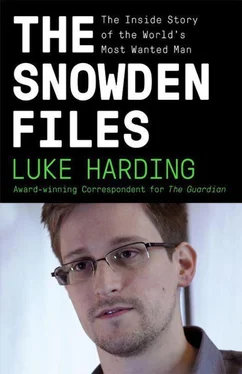UPSTREAM is explained in one slide ‘as the collection of communications on fibre cables and infrastructure as data flows past’. The slide shows a map of the US with brown cables extending in both directions across the Pacific and Atlantic oceans. The diagram looks like the thick tentacles of an enormous sea creature. Seemingly, the US has international cable taps in South America, East Africa and the Indian Ocean. There are green loops around the cables. They link to a box marked UPSTREAM. Below is a second box labelled PRISM. Linking both boxes is an instruction to the agency’s data collectors: ‘You should use both.’
According to author James Bamford, citing earlier NSA whistleblower William Binney, UPSTREAM captures 80 per cent of communications. PRISM scoops up anything that UPSTREAM may have missed.
Snowden referred to UPSTREAM when he told Greenwald: ‘The NSA doesn’t limit itself to foreign intelligence. It collects all communications that transit the US. There are literally no ingress or egress points anywhere in the continental US where communications can enter or exit without being monitored and collected and analysed.’
Since a large amount of the world’s internet traffic travels through the US and 25 per cent of it also crosses Britain, the two spy agencies between them have the ability to hack most of the globe’s key communications. A 2009 report by the NSA’s inspector general, leaked by Snowden, acknowledges this. It says: ‘The United States carries out foreign intelligence activities through a variety of means. One of the most effective means is to partner with commercial entities to obtain access to information that otherwise would not be available.’
The report refers to ‘America’s homefield advantage as the primary hub for worldwide telecommunications’. It says that the NSA currently has relationships with over ‘100 US companies’. This private sector/spy agency collaboration stretches ‘as far back as World War Two’.
Thanks to ties to two unnamed companies in particular, the NSA is able to eavesdrop on the world, or as the inspector general puts it, access ‘large volumes of foreign-to-foreign communications transiting the United States through fibre-optic cables, gateway switches and data networks’.
The US has the same ‘advantage’ when it comes to international telephone calls. Most international calls are routed through a small number of switches or ‘choke-points’ in the international telephone system, en route to their final destination. Many are in the US. The country is a ‘major crossroads for international switched telephone traffic’, the report says. It gives striking figures: of the 180 billion minutes of telephone communications in 2003, 20 per cent came from or terminated in the US, and 13 per cent transited the US. The internet numbers are bigger. In 2002 only a small fraction of international internet traffic went via non-US routes.
The NSA–telecoms partnership was highly lucrative. In return for access to 81 per cent of international telephone calls, Washington pays the private telecom giants many hundred millions of dollars a year. It is not known how much the British government pays its own domestic ‘intercept partners’, particularly the formerly state-owned BT, and Vodafone. But the sums will be similar and substantial.
By the end of the last decade, the NSA’s capabilities were astonishing. The agency, backed by Britain and its other Five Eyes allies, had access to fibre-optic cables, telephone metadata and the servers of Google and Hotmail. The NSA’s analysts were the most powerful spies in human history. Snowden maintains they were able to target practically anybody, at any time, including the president.
‘The NSA and the intelligence community in general is focused on getting intelligence everywhere and by any means possible,’ he says. ‘Originally we saw this focus very narrowly targeted on foreign intelligence. Now we see it’s happening domestically. To do that the NSA specifically targets the communications of everyone. It ingests them by default. It collects them in its systems. It filters them and it analyses them and it measures them and it stores them for periods of time simply because that’s the easiest and most efficient and most valuable way to achieve these ends.’
Looked at as a whole, the files lend weight to Snowden’s assertion that as an NSA analyst he had super-powers.
‘While they may be intending to target someone associated with a foreign government or someone they suspect of terrorism, they are collecting your communications to do so. Any analyst at any time can target anyone. Any selector, anywhere. Whether these communications may be picked up depends on the range of the sensor networks and the authorities an analyst is empowered with. Not all analysts have the ability to target everybody. But I, sitting at my desk, certainly had the authority to wiretap anyone, from you, to your accountant, to a federal judge, and even the president, if I had a personal email [address].’
The PRISM revelations provoked a howling response from the hi-tech denizens of San Francisco’s Bay Area. First there was bafflement, then denial, followed by anger. The Santa Clara valley, where most of the big tech firms are situated, likes to see itself as anti-government. The philosophical currents that waft through Cupertino and Palo Alto are libertarian and anti-establishment, a legacy of Silicon Valley’s roots in the hacker community. At the same time, these firms vie for government contracts, hire ex-Washington staff for the inside track and spend millions lobbying for legislation in their favour.
Clearly, the allegation that they were co-operating with America’s most powerful spy agency was a corporate disaster, as well as being an affront to the Valley’s self-image, and to the view of the tech industry as innovative and iconoclastic. Google prided itself on its mission statement ‘Don’t be evil’; Apple used the Jobsian imperative ‘Think Different’; Microsoft had the motto ‘Your privacy is our priority’. These corporate slogans now seemed to rebound upon their originators with mocking laughter.
Before the Guardian published the PRISM story the paper’s US business reporter, Dominic Rushe, went through his contacts book. He called Sarah Steinberg, a former Obama administration official, and now Facebook’s PR, as well as Steve Dowling, the head of PR at Apple. He rang Microsoft, PalTalk and the others. All denied any voluntary collaboration with the NSA.
‘There was total panic. They said they had never heard of it [PRISM],’ Rushe recalls. ‘They said they hadn’t given direct access to anybody. I was totally bombarded with telephone calls from increasingly senior tech executives who had more questions than answers.’
The tech companies said that they only released information to the NSA in response to a specific court order. There were no blanket policies, they said. Facebook revealed that in the last six months of 2012 it gave the personal data of between 18,000 and 19,000 users to various US law-enforcement bodies, not just to the NSA but also to the FBI, federal agencies and local police.
Several of the companies stressed they had mounted legal challenges in the FISA courts to try and say more about secret government requests for information. Google insisted: ‘We do not provide any government, including the US government, with access to our systems.’ Google’s chief architect Yonatan Zunger remarked: ‘We didn’t fight the cold war just so we could rebuild the Stasi ourselves.’ Yahoo said it had fought a two-year battle for greater disclosure, and had challenged amendments to the 2008 Foreign Intelligence Surveillance Act. Its efforts were thus far unsuccessful.
The NSA documents, though, look explicit. They say ‘direct access’.
Читать дальше












